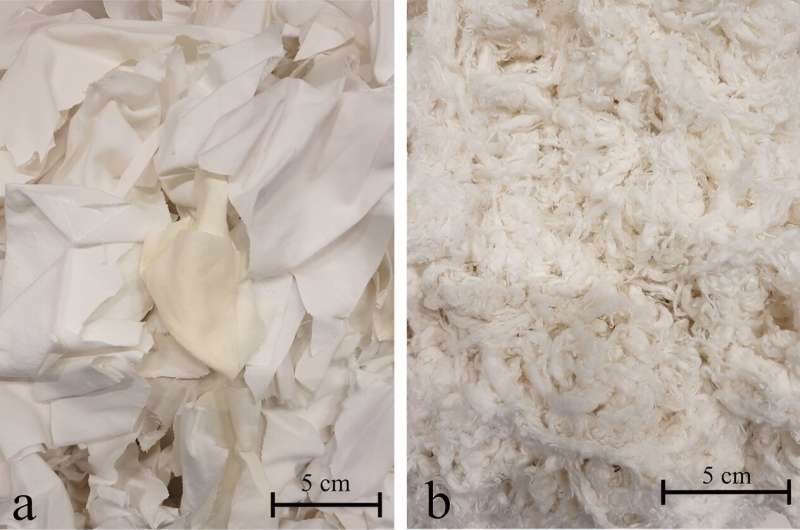This article has been reviewed according to Science X's editorial process and policies. Editors have highlighted the following attributes while ensuring the content's credibility:
fact-checked
trusted source
proofread
Researchers create viscose from recycled textiles

At present, viscose textiles are made of biomass from the forest, and there is no such thing as fully recycled viscose. Researchers at Lund University in Sweden have now succeeded in making new viscose—from worn-out cotton sheets.
Old textiles around the world end up at the rubbish tip and are often burned. In Sweden, they are generally burned to produce district heating. Extensive development work is being conducted to give old clothes and textiles a worthier end.
The planet really needs recycled textiles, as it takes a lot of energy, water and land to cultivate cotton and other plant sources for textiles.
However, there are many challenges.
"Cellulose chains, the main component in plant fibers, are complex and long. Cotton textiles are also intensively treated with dyes, protective agents and other chemicals. And then there is all the ingrained grime in the form of skin flakes and fats," says Edvin Bågenholm-Ruuth, doctoral student in chemical engineering at Lund University.
He and his colleagues have now found a way to loosen up and convert the complex cotton fibers into viscose fibers. Viscose, sometimes referred to as artificial silk, is a common constituent of clothes such as blouses, skirts and dresses. The raw material is cellulose, in most cases wood.
A new technique, developed by Edvin Bågenholm-Ruuth and his colleagues, could soon be a commercial proposition that instead produces viscose from recycled textiles—and therefore saves on valuable forest resources. The study is published in the journal Cellulose.
There are already viscose variants that are to some extent produced using old cotton fibers. However, a satisfactory product often requires a high percentage of "virgin" fiber.
Late last year, the researchers published a study that shows the process. In the coming years there are plans for a pilot plant somewhere in Europe. The method has already been tested regarding the spinning of viscose threads, and the results were excellent.
One advantage is that it looks like the process will be inexpensive. It requires a quite simple salt—zinc chloride—which dissolves in water. Another advantage is that a smaller percentage of the toxic substance carbon disulfide is needed compared to standard processes. The result is good-quality viscose fiber, even though the process needs to be further optimized, according to Edvin Bågenholm-Ruuth.
"We have used white textiles, but if you use old, dyed clothes, you may need to add a stage that decolorizes the clothes. If this can be done while also avoiding traditional bleaching, it is preferable, as bleaching is a very resource-intensive process with a considerable environmental impact."
The process
The textiles are placed in a zinc chloride solution and within one hour everything is transformed into a gooey mass.
Water is added, leading to the precipitation of a fluffy white mass known as a "dissolving pulp," which can be filtered off from the liquid. This pulp can then replace the corresponding wood pulp used in today's viscose process.
In the next stage, the pulp is treated with a number of chemicals, including carbon disulfide, to make it soluble in sodium hydroxide. The pulp is dissolved, spun and then cut into viscose fibers.
More information: Edvin Bågenholm-Ruuth et al, Transforming post-consumer cotton waste textiles into viscose staple fiber using hydrated zinc chloride, Cellulose (2023). DOI: 10.1007/s10570-023-05646-2


















